Drinking Water Protection
- Drinking Water Protection Home
- About Us
- A-Z Index of Contaminants in Water
- Community Public Water Supply
- Drinking Water Grants and Loans
- Drinking Water Institute
- Drinking Water in Schools and Child Cares
- Drinking Water Revolving Fund
- Laws and Rules
- Noncommunity Public Water Supply
- Source Water Protection
- Water Operator and Certification Training
- Drinking Water Protection Contacts
Related Topics
- Annual Reports
- Drinking Water Risk Communication Toolkit
- Drinking Water Protection External Resources
- Fact Sheets
- Forms
- Invisible Heroes Videos: Minnesota's Drinking Water Providers
- Noncom Notes Newsletter
- Sample Collection Procedures (videos, pictures, written instructions)
- Waterline Newsletter
Related Sites
- 10 States Standards
- Clean Water Fund
- Health Risk Assessment – Guidance Values and Standards for Water
- Minnesota Well Index
- Water and Health
- Wells and Borings
Environmental Health Division
Cold Spring Opens First Treatment Plant in State to Treat Nitrate Biologically
From the Winter 2023-2024 Waterline
Quarterly Newsletter of the Minnesota Department of Health Public Water Supply Unit, Waterline
A complete list of feature stories can be found on the Waterline webpage.
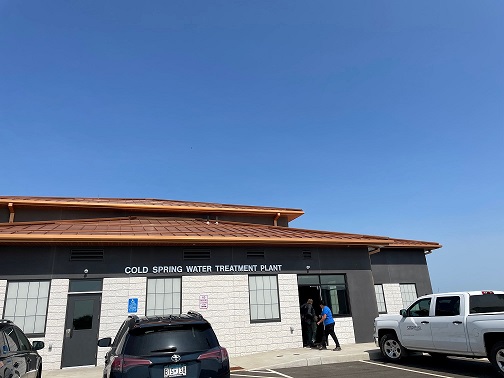
Known for beer and baseball, the central Minnesota city of Cold Spring relies on a steady supply of safe drinking water to keep its businesses humming and its 4,000 residents hydrated. Cold Spring is typical in this regard, its most important resource not being its most prominent. And like other townships and cities in the area, Cold Spring is surrounded by farms and the corresponding challenges agriculture brings to its aquifers, often seen through rising nitrate levels in water.
However, Cold Spring employees note that the issues are a result of more than farming and fertilizers. Public works director Jon Stueve said that agriculture was more of a problem historically than now. “The Department of Ag [Minnesota Department of Agriculture] has done a lot, especially in this area, with the farmers, and they regulate what they do put on the fields. There is a lot of participation from our farmers. They’re doing all they can.”
Tanya Schmidt, the city’s water and wastewater supervisor, echoed Stueve’s sentiments. “When the new generation [of farmers] comes in, you can see it. I grew up on a farm, and I can see the difference when you get the younger generation coming in,” she said before touching on the primary issue they face. “It’s tough geology here.”
Cold Spring has four wells ranging from 63 to 125 feet deep that draw from Quaternary Water Table aquifer. The city has stayed below the maximum contaminant level of 10 parts per million (ppm) for nitrate and was able to keep the level around 5 ppm by blending the wells. Nevertheless, there was a desire to bring the nitrate down even more.
The first approach involved looking for different water sources, according to Ryan Capelle of Stantec, a Minneapolis engineering firm that studied Cold Spring’s options. Quickly determining that treatment would be necessary, Stantec partnered with the city and AdEdge Water Technologies, LLC of Duluth, Georgia, on a pilot study with input and guidance from the Minnesota Department of Health (MDH).
Ion exchange is a common technique for reducing nitrate, but Capelle cited operational issues, particularly the waste stream it would create, as a drawback. Other technologies have been emerging, including one that has been a staple in wastewater treatment: biological filtration. Bacteria has long been used to consume waste materials in water.
In 2007, Hutchinson became the first Minnesota city to use the process for drinking water. Eric Meester, an engineer on the Hutchinson project, said that the longtime success of chemicals for treating drinking water caused resistance to alternative technologies, adding, “The success of chemical treatment has been documented for a long time. Biological removal has occurred naturally for longer, but no one looked for it or why it existed.”
While Hutchinson chose bacteria to treat for iron and manganese and others have used it to reduce ammonia in the water, Cold Spring became the first in the state to use it for nitrate removal. It was “a willingness of Jon and Tanya to be pioneers that opened the door to look at treatment under a new light,” said Capelle. Timing was a factor, too, with the city getting $4 million in a 2018 state bonding bill. “The technology emerged at the right time,” added Capelle. “People were willing to embrace it.”
The pilot study began in 2018 in the bottling facility of Cold Spring Brewing Company, adjacent to the city’s wells and the site of the new plant, which went on-line in May 2023. A two-stage fixed-bed biological treatment system, the process is efficient operationally in addition to being environmentally friendly.
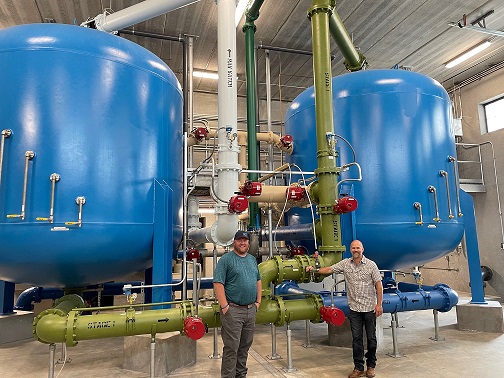
Above: Jon Stueve and Ryan Capelle in front of the filters.
Below: Capelle points out the direction of the incoming water to Maria Spitael of the Minnesota Department of Health.
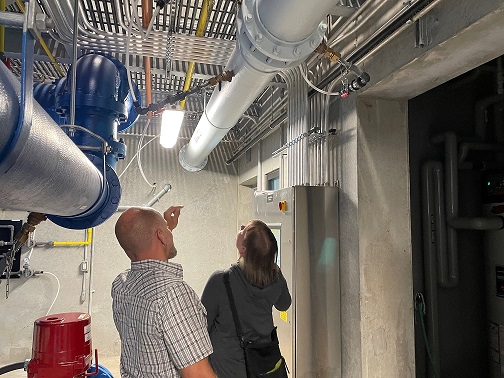
The two-stage process starts in a pressure filter with granular activated carbon (GAC) “This is where the magic happens,” said MDH engineer Brian Noma. The filter is where the denitrifying bacteria live in anoxic (low oxygen) conditions. Acetic acid is added as a carbon source and phosphoric acid as a nutrient. “This creates a favorable environment for the microbes to flourish,” explained Capelle. “This makes them hungry, makes them want to eat the nitrate in Stage 1.
“And now the nitrate is all virtually removed. We then add oxygen with peroxide. We are reoxygenating on the way to stage 2.” The second filter, consisting of 30 inches of GAC on top of 20 inches of sand, removes the excess biomass, in essence polishing the water.
Any of the four wells can go directly to the clearwell or through the plant. “It’s about a 50-50 split,” Capelle said, describing it as a header-type system to blend with any given well and produce 500 treated gallons per minute.
Chlorine is available at the front end of the clearwell, fed at a low dose after treatment. “We don’t want to overchlorinate because that is our source for backwash water,” Capelle said. “We don’t want the backwash water to kill the microbes, so we want the chlorine residual to be low, but not nonexistent at this point.”
The $6 million project included a pipe gallery, additional clearwell capacity, a laboratory and control room, and a large chemical room that allows them to buy in bulk, according to Steuve.
The results have been as desired, the finished water coming out with under 5 ppm, less than half of the MCL.
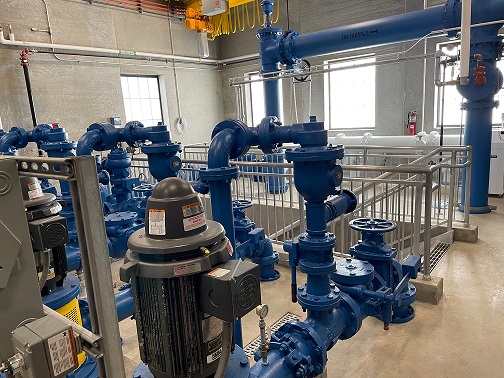
Photos of the pipe gallery and the top of the pressure filters.
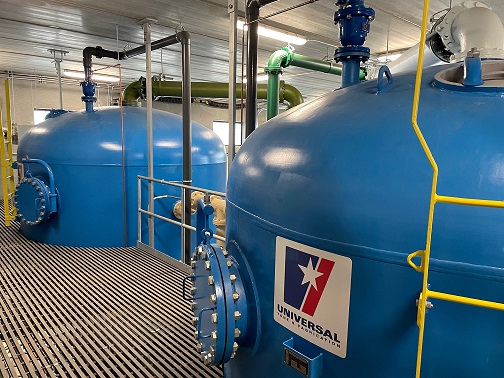
Go to > top.